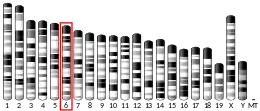| HOXA13 | |||||||||||||||||||||||||||||||||||||||||||||||||||
|---|---|---|---|---|---|---|---|---|---|---|---|---|---|---|---|---|---|---|---|---|---|---|---|---|---|---|---|---|---|---|---|---|---|---|---|---|---|---|---|---|---|---|---|---|---|---|---|---|---|---|---|
| |||||||||||||||||||||||||||||||||||||||||||||||||||
| Identifiers | |||||||||||||||||||||||||||||||||||||||||||||||||||
| Aliases | HOXA13, HOX1, HOX1J, homeobox A13 | ||||||||||||||||||||||||||||||||||||||||||||||||||
| External IDs | OMIM: 142959 MGI: 96173 HomoloGene: 73882 GeneCards: HOXA13 | ||||||||||||||||||||||||||||||||||||||||||||||||||
| |||||||||||||||||||||||||||||||||||||||||||||||||||
| |||||||||||||||||||||||||||||||||||||||||||||||||||
| |||||||||||||||||||||||||||||||||||||||||||||||||||
| |||||||||||||||||||||||||||||||||||||||||||||||||||
| |||||||||||||||||||||||||||||||||||||||||||||||||||
| Wikidata | |||||||||||||||||||||||||||||||||||||||||||||||||||
| |||||||||||||||||||||||||||||||||||||||||||||||||||
Homeobox protein Hox-A13 is a protein that in humans is encoded by the HOXA13 gene.[5][6][7]
Function
In vertebrates, the genes encoding the class of transcription factors called homeobox genes are found in clusters named A, B, C, and D on four separate chromosomes. Expression of these proteins is spatially and temporally regulated during embryonic development. This gene is part of the A cluster on chromosome 7 and encodes a DNA-binding transcription factor which may regulate gene expression, morphogenesis, and differentiation.[7]
Clinical significance
Expansion of a polyalanine tract in the encoded protein can cause hand-foot-genital syndrome, also known as hand-foot-uterus syndrome.[8] Aberrant expression of HoxA13 gene products in the esophagus, provokes Barrett’s esophagus, a form of metaplasia that is a direct precursor to esophageal cancer.[9]
See also
References
- 1 2 3 GRCh38: Ensembl release 89: ENSG00000106031 - Ensembl, May 2017
- 1 2 3 GRCm38: Ensembl release 89: ENSMUSG00000038203 - Ensembl, May 2017
- ↑ "Human PubMed Reference:". National Center for Biotechnology Information, U.S. National Library of Medicine.
- ↑ "Mouse PubMed Reference:". National Center for Biotechnology Information, U.S. National Library of Medicine.
- ↑ McAlpine PJ, Shows TB (Jul 1990). "Nomenclature for human homeobox genes". Genomics. 7 (3): 460. doi:10.1016/0888-7543(90)90186-X. PMID 1973146.
- ↑ Scott MP (Nov 1992). "Vertebrate homeobox gene nomenclature". Cell. 71 (4): 551–3. doi:10.1016/0092-8674(92)90588-4. PMID 1358459. S2CID 13370372.
- 1 2 "Entrez Gene: HOXA13 homeobox A13".
- ↑ Innis, Jeffrey W (2006-07-11). Hand-Foot-Genital Syndrome. NCBI Bookshelf, GeneReviews. University of Washington, Seattle. PMID 20301596.
- ↑ Janmaat VT, Nesteruk K, Spaander MC, Verhaar AP, Yu B, Silva RA, Phillips WA, Magierowski M, van de Winkel A, Stadler HS, Sandoval-Guzmán T, van der Laan LJ, Kuipers EJ, Smits R, Bruno MJ, Fuhler GM, Clemons NJ, Peppelenbosch MP (Jun 2021). "HOXA13 in etiology and oncogenic potential of Barrett's esophagus". Nature Communications. 12 (1): 3354. doi:10.1038/s41467-021-23641-8. PMC 8184780. PMID 34099670.
Further reading
- Goodman FR, Scambler PJ (Jan 2001). "Human HOX gene mutations". Clinical Genetics. 59 (1): 1–11. doi:10.1034/j.1399-0004.2001.590101.x. PMID 11206481. S2CID 38364372.
- Utsch B, Becker K, Brock D, Lentze MJ, Bidlingmaier F, Ludwig M (May 2002). "A novel stable polyalanine [poly(A)] expansion in the HOXA13 gene associated with hand-foot-genital syndrome: proper function of poly(A)-harbouring transcription factors depends on a critical repeat length?". Human Genetics. 110 (5): 488–94. doi:10.1007/s00439-002-0712-8. PMID 12073020. S2CID 22181414.
- Acampora D, D'Esposito M, Faiella A, Pannese M, Migliaccio E, Morelli F, Stornaiuolo A, Nigro V, Simeone A, Boncinelli E (Dec 1989). "The human HOX gene family". Nucleic Acids Research. 17 (24): 10385–402. doi:10.1093/nar/17.24.10385. PMC 335308. PMID 2574852.
- Apiou F, Flagiello D, Cillo C, Malfoy B, Poupon MF, Dutrillaux B (1996). "Fine mapping of human HOX gene clusters". Cytogenetics and Cell Genetics. 73 (1–2): 114–5. doi:10.1159/000134320. PMID 8646877.
- Mortlock DP, Innis JW (Feb 1997). "Mutation of HOXA13 in hand-foot-genital syndrome". Nature Genetics. 15 (2): 179–80. doi:10.1038/ng0297-179. PMID 9020844. S2CID 24522600.
- Sanger Centre, The; Washington University Genome Sequencing Cente, The (Nov 1998). "Toward a complete human genome sequence". Genome Research. 8 (11): 1097–108. doi:10.1101/gr.8.11.1097. PMID 9847074.
- Post LC, Innis JW (Dec 1999). "Infertility in adult hypodactyly mice is associated with hypoplasia of distal reproductive structures". Biology of Reproduction. 61 (6): 1402–8. doi:10.1095/biolreprod61.6.1402. PMID 10569982.
- de Stanchina E, Gabellini D, Norio P, Giacca M, Peverali FA, Riva S, Falaschi A, Biamonti G (Jun 2000). "Selection of homeotic proteins for binding to a human DNA replication origin". Journal of Molecular Biology. 299 (3): 667–80. doi:10.1006/jmbi.2000.3782. PMID 10835276.
- Goodman FR, Bacchelli C, Brady AF, Brueton LA, Fryns JP, Mortlock DP, Innis JW, Holmes LB, Donnenfeld AE, Feingold M, Beemer FA, Hennekam RC, Scambler PJ (Jul 2000). "Novel HOXA13 mutations and the phenotypic spectrum of hand-foot-genital syndrome". American Journal of Human Genetics. 67 (1): 197–202. doi:10.1086/302961. PMC 1287077. PMID 10839976.
- Zhao Y, Potter SS (Aug 2001). "Functional specificity of the Hoxa13 homeobox". Development. 128 (16): 3197–207. doi:10.1242/dev.128.16.3197. PMID 11688568.
- Fujino T, Suzuki A, Ito Y, Ohyashiki K, Hatano Y, Miura I, Nakamura T (Feb 2002). "Single-translocation and double-chimeric transcripts: detection of NUP98-HOXA9 in myeloid leukemias with HOXA11 or HOXA13 breaks of the chromosomal translocation t(7;11)(p15;p15)". Blood. 99 (4): 1428–33. doi:10.1182/blood.V99.4.1428. PMID 11830496.
- Kosaki K, Kosaki R, Suzuki T, Yoshihashi H, Takahashi T, Sasaki K, Tomita M, McGinnis W, Matsuo N (Feb 2002). "Complete mutation analysis panel of the 39 human HOX genes". Teratology. 65 (2): 50–62. doi:10.1002/tera.10009. PMID 11857506.
- Innis JW, Goodman FR, Bacchelli C, Williams TM, Mortlock DP, Sateesh P, Scambler PJ, McKinnon W, Guttmacher AE (May 2002). "A HOXA13 allele with a missense mutation in the homeobox and a dinucleotide deletion in the promoter underlies Guttmacher syndrome" (PDF). Human Mutation. 19 (5): 573–4. doi:10.1002/humu.9036. hdl:2027.42/35180. PMID 11968094. S2CID 26468280.
- Taketani T, Taki T, Ono R, Kobayashi Y, Ida K, Hayashi Y (Aug 2002). "The chromosome translocation t(7;11)(p15;p15) in acute myeloid leukemia results in fusion of the NUP98 gene with a HOXA cluster gene, HOXA13, but not HOXA9". Genes, Chromosomes & Cancer. 34 (4): 437–43. doi:10.1002/gcc.10077. PMID 12112533. S2CID 20992707.
- Debeer P, Bacchelli C, Scambler PJ, De Smet L, Fryns JP, Goodman FR (Nov 2002). "Severe digital abnormalities in a patient heterozygous for both a novel missense mutation in HOXD13 and a polyalanine tract expansion in HOXA13". Journal of Medical Genetics. 39 (11): 852–6. doi:10.1136/jmg.39.11.852. PMC 1735011. PMID 12414828.
External links
- GeneReviews/NCBI/NIH/UW entry on Hand-Foot-Genital Syndrome
- HOXA13+protein,+human at the U.S. National Library of Medicine Medical Subject Headings (MeSH)
This article incorporates text from the United States National Library of Medicine, which is in the public domain.




